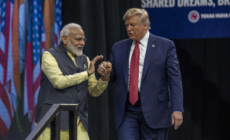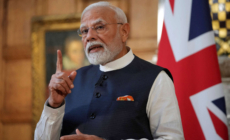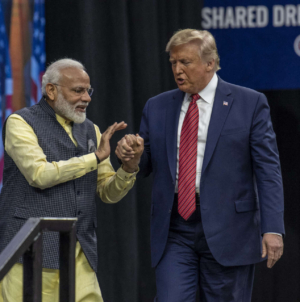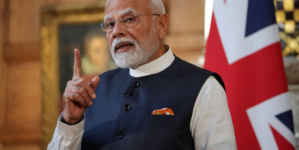-
Trump’s Relationship With Modi Sours Over Putin - 30 mins ago
-
‘Dream come true:’ Son Heung-min Joins LAFC, Latest Star to Make MLS Leap - 40 mins ago
-
Historic Ruszwurm Pastry Shop Closes After 15-Year Legal Battle - about 1 hour ago
-
China Clashes With US Ally Over Rocket Launch - about 1 hour ago
-
Rays vs. Angels Highlights | MLB on FOX - about 1 hour ago
-
Defense Forces Gear Up with Ultra-Modern Lynx Armored Vehicles - 2 hours ago
-
India’s Modi Sends Message to Trump Over Tariffs - 2 hours ago
-
Cardinals vs. Dodgers Highlights | MLB on FOX - 2 hours ago
-
Aaron Donald Sparks NFL Comeback Buzz After Conversation With Micah Parsons - 2 hours ago
-
Industrial production still in terrible shape - 3 hours ago
New tariffs snap into effect, raising import taxes to highest level since Great Depression
After months of delays and extensions, President Donald Trump’s comprehensive and sweeping tariffs slate took effect Thursday just after midnight ET, shifting his global trade reset into high gear.
Most imports into the United States will now face a baseline 10% duty, with the overall average effective tariff rate rising to more than 17% — the highest since 1935, during the Great Depression — thanks to higher duties on some of the biggest U.S. trading partners, according to the nonpartisan Yale Budget Lab think tank.
A wide variety of products will be hit. Tariffs will be collected on everything from European Union appliances and Japanese cars to food, furniture and toys from China and TVs from South Korea. Selected oil and gas imports, along with some smartphones and a suite of goods covered by a pre-existing trade agreement with Canada and Mexico, are not affected.
Together, the duties are the most significant move yet by a president set on tilting the global economy even more in favor of the United States.
Trump was online to celebrate the moment.
“It’s midnight! Billions of dollars in tariffs are now flowing into the United States of America!” he said in an all-caps post on Truth Social.
So far, the duties have mainly been jostling the U.S. economy instead. Tariffs, which are taxes on imports collected by the federal government, generally tend to raise costs, although there is some debate among economists about whether businesses or consumers ultimately bear the weight of those increased prices.
Yale’s Budget Lab calculates that the inflationary effect of tariffs will cost a typical household an average of as much as $2,400 this year. It forecasts one of the biggest impacts in clothing, with consumers facing 40% higher prices for shoes and 38% higher costs for apparel in the short run as retailers that rely on importing clothes from South and Southeast Asia shift supply chains or grapple with higher costs.
Thursday is not the end of Trump’s trade offensive, either.
Trump told CNBC on Tuesday he still plans to impose import taxes on pharmaceutical products and semiconductors. Currently, only about a quarter of manufacturing facilities supplying the United States with key drug ingredients are actually based here, equating to a $116 billion deficit with the rest of the world. As for semiconductors, the United States imports $40 billion worth, though the figure can also include chips produced in the United States, shipped abroad and repackaged inside finished goods.
Trump has also shown continued willingness to ratchet up duty levels at a moment’s notice. On Wednesday, he hiked the tariff rate for India to 50% over the nation’s purchases of Russian oil, which he said was allowing Russia to continue to finance its war in Ukraine. Brazil, too, now faces 50% duties as a result of Trump’s displeasure with its treatment of former President Jair Bolsonaro, a Trump ally who has been detained on coup charges.
Trump also told CNBC he could raise the European Union’s tariff level to 35% from 15% if it reneges on an investment commitment. Taken together, the 27-nation bloc is the largest U.S. trading partner.
The Trump administration continues to insist tariffs are working, pointing to billions raised in new monthly revenues for the U.S. government. The White House also notes that nations have pledged hundreds of billions of dollars in investments, though no details about how that money will be spent have been released. Stock indexes have also set all-time highs.
“The markets have seen what we’re doing and celebrated,” Kevin Hassett, director of Trump’s National Economic Council, said Sunday on NBC News’ “Meet the Press.”
Market analysts say those gains have been largely driven by tech and bets on artificial intelligence, offsetting growing signs of weakness elsewhere, like a slowing labor market and softer consumer spending.
Overall, the U.S. economy as a whole now appears to be on much shakier ground than at the start of the year. Price growth has continued to pick up, while employment growth in manufacturing — the sector Trump and his allies have said would benefit most from the tariffs — has flatlined.
Some of that may also be attributable to elevated interest rates. But even non-manufacturing sectors are feeling the pinch.
Comments cited in the Institute for Supply Chain Management’s survey of service-providing businesses for July, released this week, were filled with concerns about tariffs.
“Anticipation of the final tariff impacts is resulting in delayed planning for next fiscal year purchases,” an accommodation and food-services firm said.
A health services firm said: “Tariffs are causing additional costs as we continue to purchase equipment and supplies. Though we need to continue with these purchases, the cost is significant enough that we are postponing other projects to accommodate these cost changes.”
The U.S. unemployment rate has held steady at 4.2%, still considered low — but most economists say that is partly a function of Trump’s immigration crackdown, which has shrunk the overall labor force. The unemployment rate among native-born Americans reached a pandemic-era high last month of 4.7%.
Business leaders are shaken up, too. Gartner Research said this week that its measure of CEO confidence has fallen at one of the fastest paces ever to recessionary levels, with 78% of top executives indicating they’re implementing cost-cutting measures to safeguard performance. On Tuesday, equipment manufacturers Caterpillar and Eaton both reported significant profit hits from tariffs that constrained financial results amid resilient demand.
“With the prospect of higher tariffs, many companies implemented strong cost saving measures,” Gartner said. “Even companies not directly impacted by tariffs began implementing these measures.”
There remains an outside chance that the courts will strike the tariffs down. A group of small businesses has sued the Trump administration challenging its authority to impose tariffs under emergency powers. A trade court agreed in late May, but Trump’s lawyers obtained an injunction to keep the tariffs he had already imposed in effect. All of Trump’s tariffs on individual trading partners have been deployed using the law, which faces additional challenges from other suits.
Tariffs he has imposed on specific goods, like steel and copper, have been issued under a separate authority.
In April, a bipartisan group of senators passed a bill to assert Congress’ authority as the only body allowed to impose tariffs, but the measure stalled in the House.
A growing chorus of analysts is raising the prospect of stagflationary conditions, in which price growth increases while the job market weakens.
“Economic activity and job growth are sputtering under the weight of higher tariffs, increasing inflation and rising economic policy and trade uncertainty,” analysts with BMO said in a recent note to clients.
As higher tariff rates continue to creep up, stagflation and even a recession become likelier, Mark Zandi, chief economist at Moody’s Analytics, told NBC News last week.
“I think the economic fallout from the tariffs is now obvious: higher inflation and a struggling economy,” he said.
Source link































